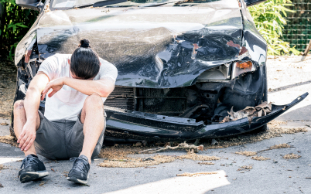Car accidents are never easy to navigate, and depending upon the severity of the auto accident, they can leave you disoriented and uncertain of what to do next.
When a collision occurs, it’s crucial to understand what happens next, particularly when protecting yourself, your property, and your loved ones. Here are seven essential steps to take as soon as the collision takes place.
1. Check on the Safety of All Passengers
Before anything else, check on your own safety and the safety of your passengers. If an injury has occurred, do your best to assess whether immediate medical treatment is necessary. Once (and if) you know that you and your passengers are okay, it’s a good idea to check on the other motor vehicles involved and ensure there are no serious injuries.
When interacting with others involved in the accident, be sure not to discuss (or admit) fault with the other driver. Even if it’s a minor accident, check on all parties to ensure everyone is okay.
2. Move to Safety, if Possible
Depending on where the accident occurred, you may want to work with all involved parties to move to a safer location. Moving to a safer vehicle location can help reduce stress and renew focus on the situation. Use your hazard lights to move safely to a better area.
If possible, try to take a few of the pictures (mentioned below) before moving. This can provide a good sense of context and help put the automobile accident on record.
3. Call the Police
Call 911 so law enforcement can send an officer to check on the situation and begin to create a police report. The police typically respond as quickly as possible, and their timing usually depends on where the nearest police station is). You may have to wait a bit, depending on your location. You may also let the other driver know you have called the police, so everyone is on the same page.
4. Take Pictures
Take pictures of the scene, including all vehicles, their locations (in relation to each other), street names, close traffic signals, license plate numbers, and documents such as the driver’s insurance card of the other party involved. Be sure to take pictures from multiple angles, especially of vehicle damage and vehicle placement.
This record can help your insurance company (or the other driver’s insurance company) when the claims process has begun. It can also give the police a good sense of the accident scene in case they haven’t arrived before vehicles have been moved for safety reasons.
Documenting property damage to your (or the other driver’s) vehicle is important, particularly if there are any disputes within or about the accident report.
5. Exchange Insurance and Contact Information
To ensure everyone remains on the same page and has the resources needed to proceed, take time to exchange information with the other driver (or drivers). This should include contact information, insurance company information (policy number), driver’s license numbers, vehicle registration, the other driver’s insurer, and any other details that may be needed to file a claim. You’ll need this info as you begin the claims process with your insurance professional.
6. Document Other Details
Consider documenting any other details about the scene – those that will help you navigate the next steps. Write down the names of the other drivers involved (and other persons affected), info about the roadside assistance company you use, and the location of the scene of the accident. Be sure to record the police officer’s name and badge number, the timing of events, the police report number, and any other relevant information about the accident.
7. Call Your Insurance Company
Finally, call your insurance agent to discuss the car accident and get their advice and instruction for any car insurance claim you need to file. Depending on who is at fault and the specific nature of the accident, your conversation could go many different ways.
Most importantly, be sure to tell your agent you were involved in a motor vehicle collision and whether there were injuries. Ask them how you should proceed concerning car insurance information. For example, you may need a rental car, which may be covered as part of your insurance claim (depending on your insurance policy). You may also need a tow truck to pick up your vehicle.
Get Legal Help When You Need It
If you’re navigating a difficult car accident situation and need to connect with legal and medical experts in your area, contact 1-800-ASK-GARY. We can connect you to law professionals today.


